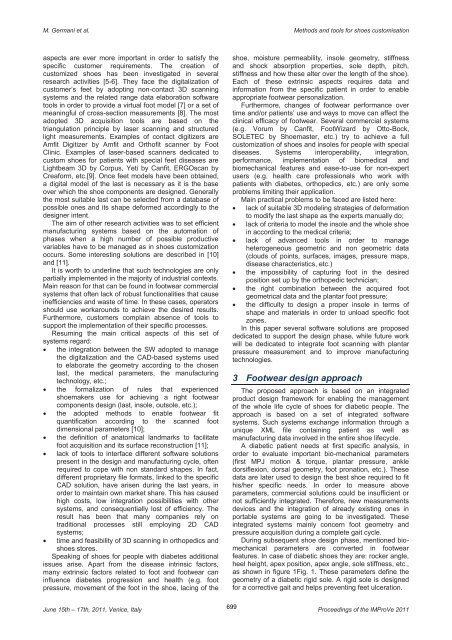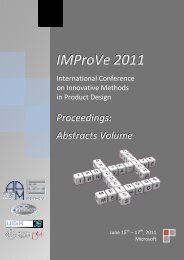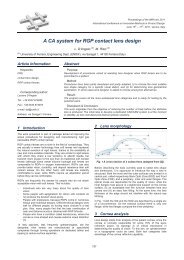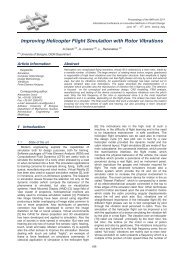Methods and tools dedicated to shoes customization ... - IMProVe2011
Methods and tools dedicated to shoes customization ... - IMProVe2011
Methods and tools dedicated to shoes customization ... - IMProVe2011
Create successful ePaper yourself
Turn your PDF publications into a flip-book with our unique Google optimized e-Paper software.
M. Germani et al. <strong>Methods</strong> <strong>and</strong> <strong><strong>to</strong>ols</strong> for <strong>shoes</strong> cus<strong>to</strong>misationaspects are ever more important in order <strong>to</strong> satisfy thespecific cus<strong>to</strong>mer requirements. The creation ofcus<strong>to</strong>mized <strong>shoes</strong> has been investigated in severalresearch activities [5-6]. They face the digitalization ofcus<strong>to</strong>mer’s feet by adopting non-contact 3D scanningsystems <strong>and</strong> the related range data elaboration software<strong><strong>to</strong>ols</strong> in order <strong>to</strong> provide a virtual foot model [7] or a set ofmeaningful of cross-section measurements [8]. The mostadopted 3D acquisition <strong><strong>to</strong>ols</strong> are based on thetriangulation principle by laser scanning <strong>and</strong> structuredlight measurements. Examples of contact digitizers areAmfit Digitizer by Amfit <strong>and</strong> Orthofit scanner by FootClinic. Examples of laser-based scanners <strong>dedicated</strong> <strong>to</strong>cus<strong>to</strong>m <strong>shoes</strong> for patients with special feet diseases areLightbeam 3D by Corpus, Yeti by Canfit, ERGOscan byCreaform, etc.[9]. Once feet models have been obtained,a digital model of the last is necessary as it is the baseover which the shoe components are designed. Generallythe most suitable last can be selected from a database ofpossible ones <strong>and</strong> its shape deformed accordingly <strong>to</strong> thedesigner intent.The aim of other research activities was <strong>to</strong> set efficientmanufacturing systems based on the au<strong>to</strong>mation ofphases when a high number of possible productivevariables have <strong>to</strong> be managed as in <strong>shoes</strong> cus<strong>to</strong>mizationoccurs. Some interesting solutions are described in [10]<strong>and</strong> [11].It is worth <strong>to</strong> underline that such technologies are onlypartially implemented in the majority of industrial contexts.Main reason for that can be found in footwear commercialsystems that often lack of robust functionalities that causeinefficiencies <strong>and</strong> waste of time. In these cases, opera<strong>to</strong>rsshould use workarounds <strong>to</strong> achieve the desired results.Furthermore, cus<strong>to</strong>mers complain absence of <strong><strong>to</strong>ols</strong> <strong>to</strong>support the implementation of their specific processes.Resuming the main critical aspects of this set ofsystems regard:the integration between the SW adopted <strong>to</strong> managethe digitalization <strong>and</strong> the CAD-based systems used<strong>to</strong> elaborate the geometry according <strong>to</strong> the chosenlast, the medical parameters, the manufacturingtechnology, etc.; the formalization of rules that experiencedshoemakers use for achieving a right footwearcomponents design (last, insole, outsole, etc.); the adopted methods <strong>to</strong> enable footwear fitquantification according <strong>to</strong> the scanned footdimensional parameters [10];the definition of ana<strong>to</strong>mical l<strong>and</strong>marks <strong>to</strong> facilitatefoot acquisition <strong>and</strong> its surface reconstruction [11];lack of <strong><strong>to</strong>ols</strong> <strong>to</strong> interface different software solutionspresent in the design <strong>and</strong> manufacturing cycle, oftenrequired <strong>to</strong> cope with non st<strong>and</strong>ard shapes. In fact,different proprietary file formats, linked <strong>to</strong> the specificCAD solution, have arisen during the last years, inorder <strong>to</strong> maintain own market share. This has causedhigh costs, low integration possibilities with othersystems, <strong>and</strong> consequentially lost of efficiency. Theresult has been that many companies rely ontraditional processes still employing 2D CADsystems;time <strong>and</strong> feasibility of 3D scanning in orthopedics <strong>and</strong><strong>shoes</strong> s<strong>to</strong>res.Speaking of <strong>shoes</strong> for people with diabetes additionalissues arise. Apart from the disease intrinsic fac<strong>to</strong>rs,many extrinsic fac<strong>to</strong>rs related <strong>to</strong> foot <strong>and</strong> footwear caninfluence diabetes progression <strong>and</strong> health (e.g. footpressure, movement of the foot in the shoe, lacing of theshoe, moisture permeability, insole geometry, stiffness<strong>and</strong> shock absorption properties, sole depth, pitch,stiffness <strong>and</strong> how these alter over the length of the shoe).Each of these extrinsic aspects requires data <strong>and</strong>information from the specific patient in order <strong>to</strong> enableappropriate footwear personalization.Furthermore, changes of footwear performance overtime <strong>and</strong>/or patients’ use <strong>and</strong> ways <strong>to</strong> move can affect theclinical efficacy of footwear. Several commercial systems(e.g. Vorum by Canfit, FootWizard by Ot<strong>to</strong>-Bock,SOLETEC by Shoemaster, etc.) try <strong>to</strong> achieve a fullcus<strong>to</strong>mization of <strong>shoes</strong> <strong>and</strong> insoles for people with specialdiseases. Systems interoperability, integration,performance, implementation of biomedical <strong>and</strong>biomechanical features <strong>and</strong> ease-<strong>to</strong>-use for non-expertusers (e.g. health care professionals who work withpatients with diabetes, orthopedics, etc.) are only someproblems limiting their application.Main practical problems <strong>to</strong> be faced are listed here: lack of suitable 3D modeling strategies of deformation<strong>to</strong> modify the last shape as the experts manually do;lack of criteria <strong>to</strong> model the insole <strong>and</strong> the whole shoein according <strong>to</strong> the medical criteria; lack of advanced <strong><strong>to</strong>ols</strong> in order <strong>to</strong> manageheterogeneous geometric <strong>and</strong> non geometric data(clouds of points, surfaces, images, pressure maps,disease characteristics, etc.)the impossibility of capturing foot in the desiredposition set up by the orthopedic technician;the right combination between the acquired footgeometrical data <strong>and</strong> the plantar foot pressure;the difficulty <strong>to</strong> design a proper insole in terms ofshape <strong>and</strong> materials in order <strong>to</strong> unload specific footzones.In this paper several software solutions are proposed<strong>dedicated</strong> <strong>to</strong> support the design phase, while future workwill be <strong>dedicated</strong> <strong>to</strong> integrate foot scanning with plantarpressure measurement <strong>and</strong> <strong>to</strong> improve manufacturingtechnologies.3 Footwear design approachThe proposed approach is based on an integratedproduct design framework for enabling the managemen<strong>to</strong>f the whole life cycle of <strong>shoes</strong> for diabetic people. Theapproach is based on a set of integrated softwaresystems. Such systems exchange information through aunique XML file containing patient as well asmanufacturing data involved in the entire shoe lifecycle.A diabetic patient needs at first specific analysis, inorder <strong>to</strong> evaluate important bio-mechanical parameters(first MPJ motion & <strong>to</strong>rque, plantar pressure, ankledorsiflexion, dorsal geometry, foot pronation, etc.). Thesedata are later used <strong>to</strong> design the best shoe required <strong>to</strong> fithis/her specific needs. In order <strong>to</strong> measure aboveparameters, commercial solutions could be insufficient ornot sufficiently integrated. Therefore, new measurementsdevices <strong>and</strong> the integration of already existing ones inportable systems are going <strong>to</strong> be investigated. Theseintegrated systems mainly concern foot geometry <strong>and</strong>pressure acquisition during a complete gait cycle.During subsequent shoe design phase, mentioned biomechanicalparameters are converted in footwearfeatures. In case of diabetic <strong>shoes</strong> they are: rocker angle,heel height, apex position, apex angle, sole stiffness, etc.,as shown in figure 1Fig. 1. These parameters define thegeometry of a diabetic rigid sole. A rigid sole is designedfor a corrective gait <strong>and</strong> helps preventing feet ulceration.June 15th – 17th, 2011, Venice, Italy699Proceedings of the IMProVe 2011










